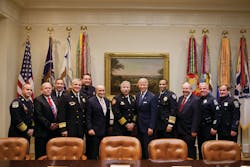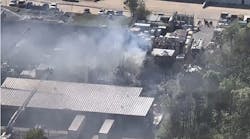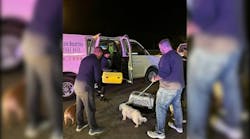For more than six years, I have been writing articles and columns to inform you about the concept of a nationwide public safety broadband wireless network. On numerous occasions, I have asked the readers of Firehouse® Magazine and Firehouse.com to reach out to members of Congress in support of this effort.
I am pleased and excited to report that your actions as part of a larger grassroots effort resulted in the passage of landmark legislation signed by President Obama on Feb. 22, 2012, to build a nationwide public safety broadband wireless network. I would like to take this opportunity to thank everyone who responded to the legislative call to action; it made the difference.
Why the need for more radio spectrum
As far back as September 1996, the Public Safety Wireless Advisory Committee (PSWAC) issued a report that outlined public safety’s need for more radio spectrum. The PSWAC was established by the Federal Communications Commission (FCC) and National Telecommunications and Information Administration (NTIA) to evaluate the wireless communications needs of federal, state, and local public safety agencies. Following the terrorist attacks on Sept. 11, 2001, the 9/11 Commission report reinforced the need for public safety spectrum. Then in 2005, Hurricane Katrina’s devastating impact on the Gulf Coast further identified the need for public safety radio spectrum and highlighted the shortcomings of interoperability.
Looking back, I remember a number of meetings with Morgan O’Brien, a co-founder of Nextel, at which he floated the concept with public safety about a nationwide public safety broadband network. In 2006, he publicly announced this idea at the International Wireless Communications Expo (IWCE) in Las Vegas, NV, which over time grew legs and began to develop. In the early days of discussions, there were conflicts between the various public safety factions that seemed to be insurmountable. Without strong public safety unity, this grand idea would have had no chance of succeeding.
The first iterations of the concept of creating a public private network surfaced through conversations between public safety and the FCC. The FCC moved forward in 2007 to publicly auction the D Block spectrum that would create a nationwide public safety broadband network with stringent public safety requirements. That auction failed as no bidder met the minimum bid requirement of $1.3 billion. There were just too many uncertainties.
Public-private partnership
While the idea of creating a public-private partnership and sharing spectrum was never an issue, the issue was “who controls it.” It became abundantly clear that an auction of the spectrum would never address the need for public safety to have control of the network during major emergencies to ensure availability and capacity when public safety needed it the most. In April 2009, the Major Cities Police Chiefs Association convened a meeting hosted by APCO-International in Alexandria, VA, with representatives of the International Association of Chiefs of Police, International Association of Fire Chiefs, National Sheriffs Association and APCO. This meeting was the first step and catalyst to the formation of what would be later known as the Public Safety Alliance (PSA). In September of 2009, the PSA asked Congress for reallocation of the D Block 700 MHz spectrum to public safety. I would add a special note of thanks to wireless industry analyst Andy Seybold, who added his technical knowledge, presence and voice in support of public safety throughout. I would also be remiss if I did not recognize the public safety vendor industry for their support of this monumental effort.
In early March 2010, the FCC released its National Broadband Plan, which required the auction of the D Block. On March 19, the Police Executive Research Forum (PERF) convened a meeting (the PERF Conference on Broadband Spectrum) of public safety thought leaders from across the country to discuss the importance of a nationwide public safety broadband wireless network, the need for control of the network and D Block reallocation to public safety. At this meeting, there was a consensus from all present that the FCC’s National Broadband Plan was unacceptable and moved this issue to Congress.
In September 2010, another key meeting was hosted by the Department of Commerce, Department of Homeland Security, Department of Justice and the Obama Administration in Reston, VA. This was the first meeting where representatives from public safety, commercial wireless companies, broadband device manufacturers and federal agencies discussed the concept of a public-private partnership regarding the network, device development and network control. This was one of the most important gatherings on the issue because it enhanced everyone’s understanding of the issues from each group’s perspective and operational needs.
subhead
On March 15, 2011, the PSA held its most important meeting – the one that established the path forward to seek public safety unity and develop a strategy for reallocation of the D Block and funding for a nationwide network. Over the next nine months, there were numerous trips by public safety leaders to Washington, meetings with members of Congress, grassroots legislative activities, articles written and press conferences. By mid-2011, public safety had become solid and the support became even more significant when the “Big 7” national state and local organizations – National Governors Association, National Association of Counties, National League of Cities, U.S. Conference of Mayors, Council of State Governments, International City/County Managers Association and National Conference of State Legislatures – joined with their support.
Legislatively, the two most significant initial bills introduced were H.R. 607 introduced by Representative Peter King (R-New York) and S.911 by Senator Jay Rockefeller (D-West Virginia) and Senator Kay Bailey Hutchinson (R-Texas). The first members of Congress to support the nationwide public safety broadband network with reallocation of the D Block to public safety through legislative bills were King, Rockefeller, Hutchison, and Senators John McCain (R-Arizona) and Joe Lieberman (I-Connecticut). This was a bipartisan effort in both houses of Congress with the support of President Obama.
It is also worth acknowledging some very key people. Vice President Joe Biden took ownership and a leadership role very early in the legislative process and was involved throughout. Other administrative leaders to be acknowledged during the legislative process are Attorney General Eric Holder and Department of Homeland (DHS) Security Secretary Janet Napolitano. White House staff members who played a key role included Terrell McSweeny, Phil Weiser and Aneesh Chopra; and Greg Schaffer, DHS assistant secretary for Cybersecurity and Communications; Anna Gomez, deputy assistant secretary for communications and information, Commerce Department, and NTIA deputy administrator; Chris Essid, director of the DHS Office of Emergency Communications; and Dereck Orr, manager of the Commerce Department’s Public Safety Communications Research (PSCR) program.
What’s next?
Included in the Middle Class Tax Relief and Job Creation Act, H.R. 3630, is a provision to allocate 10 MHz of spectrum in the 700 MHz bandwidth (known as the D Block) to public safety for the creation of a nationwide, interoperable public safety broadband network.
The D Block is adjacent to 10 MHz of spectrum currently allocated to public safety, allowing for the creation of the nationwide broadband network on 20 MHz of contiguous spectrum. The bill also provides $7 billion for construction of the network and a nationwide governance (First Responder Network Authority) model that will be overseen by the NTIA.
In addition, the legislation advances next-generation 911 services by providing $115 million in grants to upgrade 911 infrastructure to technologies that will make it possible for Public Safety Answering Points (PSAPs) to receive not only voice 911 calls, but text, video, data and images. The 911 grants can be used for the implementation and operation of 911, E911, migration to Internet Protocol (IP)-enabled emergency networks, adoption and operation of next-generation 911 services and training of public safety communications personnel.
Now, the process of implementation of this legislation begins. More information will be forthcoming as it becomes available.
For more news and training on technology and communications, visit: http://www.firehouse.com/topics/technology-communications.






